This is ONE preview lesson taken from UNIT 3 in the Online Introductory Herbal Course. The Introductory Herbal Course is made up of 6 units including over 30 lessons and bonus lessons. To learn more about the beginners program, please visit this page. If you are interested in registering for the program, skip to registration.
•••

LESSON 3: KITCHEN REMEDIES, THE DOORYARD, & WILDCRAFTING
INTRODUCTION
Now we get to the juicy, experiential part! Let’s get creative! One of the joys of kitchen herbalism is whipping up real medicine from herbs and ingredients in your cupboard and pantries. We’ve already talked about lots of other ways to make medicine in Unit 1, so here we’ll focus on vinegars, honeys, and culinary oils, which are all easy and fun to make.
HERBAL VINEGARS
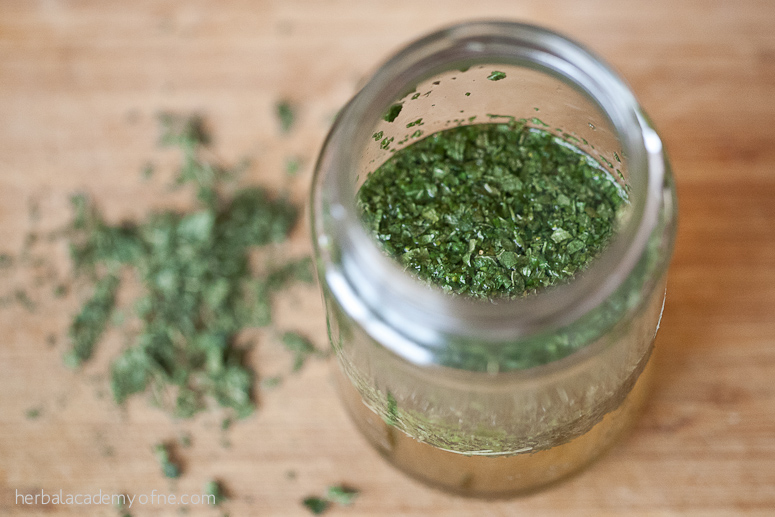 Used for many thousands of years, vinegar is an ancient product which is the result of the fermentation of ethanol by bacteria. Infused with dried herbs, vinegar can help improve the flavor of your favorite dish, can be used as herbal salad dressing, and can be given to children as an alternative to alcohol-based tinctures for colds, flus, and other ailments. Infused or not, vinegar can also be used topically as a skin toner or as a conditioner to soften hair.
Used for many thousands of years, vinegar is an ancient product which is the result of the fermentation of ethanol by bacteria. Infused with dried herbs, vinegar can help improve the flavor of your favorite dish, can be used as herbal salad dressing, and can be given to children as an alternative to alcohol-based tinctures for colds, flus, and other ailments. Infused or not, vinegar can also be used topically as a skin toner or as a conditioner to soften hair.
Most herbalists prefer apple cider vinegar (ACV) because it is raw and contains live cultures that are beneficial to digestion and overall health. Naturally fermented vinegar is also high in minerals, especially potassium, which aids in metabolism, respiration, nervous system vitality, and blood conditioning.
Other good choices for culinary vinegars include wine-based vinegars which vary in their flavorings and offer a bit more versatility than ACV. Verjus is a delicious but expensive vinegar made from unripe grapes or other sour fruit and adds an unmatched depth and flavor to dishes, especially good on greens like kale salad.
Tips and Guidelines for Infused Vinegars
- Use dried herbs for making infused vinegars whenever possible. The water content of fresh herbs can dilute the acidity of the vinegar, reducing its shelf-life. Made properly, infused vinegar can last for a long time.
- Using a grinder or mortar and pestle, turn dried herbs into a coarse powder.
- Place herbs in a clean glass jar and cover with vinegar to about an inch above the herbs. Don’t use reactive materials like soft plastic, pottery, or metal.
- If using a metal lid or a lid coated with BPA, place a few sheets of waxed paper under the lid to prevent corrosion.
- Macerate your batch for at least two weeks, shaking every day or two.
- Strain your vinegar using cheesecloth or a fine sieve or chinoise.
- Pour vinegar into a sterilized, dry bottle and cap with a nonreactive cap. Store in fridge.
Sage-Thyme-Bay Vinegar
2 cups apple cider vinegar
- Combine the herbs and vinegar and steep for two weeks.
- Taste and then filter (you can steep longer if you prefer stronger flavor).
- Pour into dry, sterilized bottles and cap tightly.
- Label and date and store in fridge.
HERBAL HONEYS
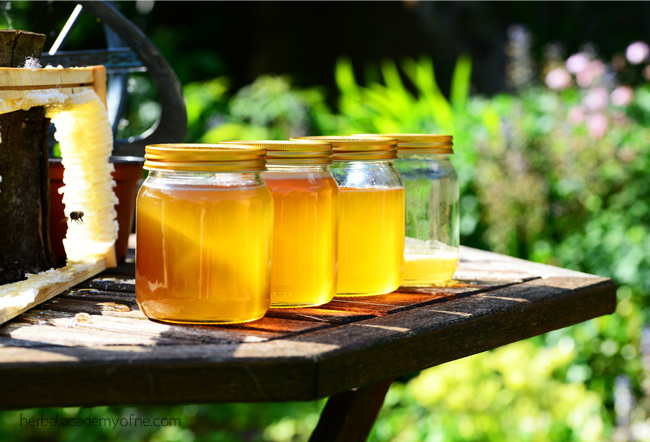 Even while the sun sets, honey bees are still working to gather nectar and pollinate our flowers and food. Drawn in by the beauty and aroma of the blossom, they sip her nectar and before regurgitating it, mix it with digestive enzymes to create an entirely new compound: the delicious, powerful substance that we know as honey. Bees work very hard to produce their honey, with each colony visiting over two million flowers to produce just one pound of honey. Out of respect for the bees on whose lives we depend, always choose local, humanely gathered honey from small-scale beekeepers who practice gentle beekeeping.
Even while the sun sets, honey bees are still working to gather nectar and pollinate our flowers and food. Drawn in by the beauty and aroma of the blossom, they sip her nectar and before regurgitating it, mix it with digestive enzymes to create an entirely new compound: the delicious, powerful substance that we know as honey. Bees work very hard to produce their honey, with each colony visiting over two million flowers to produce just one pound of honey. Out of respect for the bees on whose lives we depend, always choose local, humanely gathered honey from small-scale beekeepers who practice gentle beekeeping.
Healing honey is not to be confused with mass-produced refined honey, which may be adulterated with corn syrup or other synthetic sweeteners. Aside from containing vitamins and minerals, raw wildflower honey is soothing and highly anti-microbial and can be applied on wounds to prevent infection.
Like vinegar, honey can be used to extract and preserve the medicinal properties of plants and applied topically, honey can heal infected wounds. Infused honeys can be taken internally to make strong herbs more palatable. Infused honey enhances the flavor and medicinal properties of herbal teas. Honey should not be given to children under one year of age.
Did you know that it is estimated that about 1/3 of agricultural output depends on insect and animal pollination? Because our honeybee populations have been in peril for years now, it’s more important than ever to take action to support their health. Choose organic food and either leave your dandelions, clover, and goldenrod alone, or plant bee-loving plants like borage, bee balm, cosmos, berry plants, and others. Check out out our blog article Tips For Helping Bees.
Tips and Guidelines for Infused Honey
- Using dried, finely powdered herbs when possible means you don’t have to bother straining the honey, a nearly impossible task!
- If powdered herbs are not available, strain through a fine sieve (this requires patience!).
- In general, for every pint-sized mason jar, use 1/4 to 1/2 cup total dried herb.
- If using whole herbs, can be strained through a fine meshed strainer.
- Honey can be placed in sunny windowsill or warm greenhouse when infusing.
- Turn or gently shake honey every day or so.
- Raw, local wildflower honey, in particular, is highly beneficial to humans.
- Use a clean, dry, sterilized jar and lid.
- Experiment with flavors – the possibilities are endless!
- Don’t forget to label and date!
Cinnamon Rose Honey
Two parts dried powdered organic rose petals
One part cinnamon
Enough honey to cover herbs
Dry, sterilized jar and lid
- Place herbs into jar.
- Cover with honey.
- Let sit for a couple weeks, shaking occasionally.
- Take one teaspoon in tea or drizzled over toast or pancakes.
Marlene’s Garlic Honey
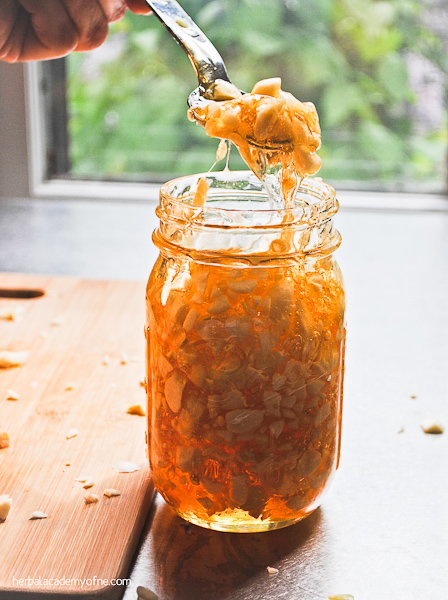 There are numerous health benefits from garlic. It is a culinary delight, adding a hearty robust and pungent flavor to our creations in the kitchen. But did you know that garlic is actually a very powerful medicine and that it has been used for thousands of years in many cultures to fight infection? Garlic creates stamina. It was used by the Olympic athletes of historical Greece and by the Roman soldiers going off to battle. Garlic may be thought of as a plentiful and common herb, but it is anything but common.
There are numerous health benefits from garlic. It is a culinary delight, adding a hearty robust and pungent flavor to our creations in the kitchen. But did you know that garlic is actually a very powerful medicine and that it has been used for thousands of years in many cultures to fight infection? Garlic creates stamina. It was used by the Olympic athletes of historical Greece and by the Roman soldiers going off to battle. Garlic may be thought of as a plentiful and common herb, but it is anything but common.
Studies have shown that garlic packs a powerful punch as an immune booster. It can help reduce artery-clogging plaque, and modestly lower blood pressure and cholesterol levels.
Garlic reduces blood clotting and modestly lowers levels of homocysteine which contributes to arterial blockage. High levels of homocysteine may indicate a greater possibility for heart disease. Some studies even suggest that garlic may help prevent Alzheimer’s disease and some cancers.
Garlic contains allicin and other sulphur compounds which makes it antibacterial, anti-fungal, anti-inflammatory, and anti parasitic. In order to release the allicin, garlic must be crushed or chopped. Choosing fresh, raw garlic is best in medicine making as it is more potent. In addition, non-irradiated garlic is preferable as it will contain the properties used for healing. (Irradiated garlic will not contain the green shoot in the middle of the clove: it will be gone or a brownish color.)
Garlic honey is a very easy remedy to prepare, using two highly effective bacterial and viral infection fighters. It can be used to help with sore throats, coughs, colds, flu and sinus infections.
Garlic Honey
3 fresh, organic garlic bulbs
Raw, local wildflower honey
Clean, sterilized, dry jar and lid
- Peel and separate the cloves and chop finely or grate, then let sit 10 minutes.
- Fill a jar about half full with chopped garlic cloves then cover with honey.
- Poke through the honey with a sterilized, dry spoon to make sure that all of the garlic is well saturated.
- Label with a description of the contents and the date it was made.
- Can let it sit for a few weeks, but can also take immediately.
- For topical application, apply directly to wound and cover with a clean bandage at least twice a day. Essential oils of sage, thyme, rosemary, or tea tree can be added for enhanced potency.
- For internal use, spread 1 tablespoon on a piece of bread and eat, or place into tea twice a day during active infection.
Other ideas to consider:
Elderberry berry and flower honey
Ginger-rose honey
Sage honey
Lemon balm honey
Cinnamon vanilla honey
CULINARY INFUSED OIL
Oil infusions use heat to transfer the oil soluble properties of herbs into the healing power of good, raw oil. These delicious oils can be added on top of your favorite dishes, including rice, stir-fry, salad, cooked greens, roasted roots, and much more.
Some of our favorite culinary oils to use are cold-pressed extra virgin olive oil, coconut oil, and hemp seed oil. You can also experiment with other oils, such as flax seed, almond, and peanut. Keeping oils in the refrigerator keeps them from spoiling and going rancid. Note that the oil may turn colors as properties are infused, but may not take on a strong scent of the plant.
Remember that there have been cases of botulism reported from plant infused oils. It is of utmost importance to use caution when creating oil infusions and we recommend beginners use dried herbs to decrease the chances of contamination. Always store culinary oils in the refrigerator.
Tips and Guidelines for Infused Oil
- Keep herbs and spices in a more whole form for ease of straining.
- Ensure that all of the herb is covered in oil.
- Using dried herbs and spices will create longer last oils. Water in fresh herbs will cause the oil to spoil more quickly.
- Use a sterilized and completely dry jar and lid.
- Do not introduce any water or moisture into the oil, jar, or onto the herbs.
- After straining, keep in refrigerator to slow bacterial growth.
- Discard after one month.
- If using fresh herbs, consider using them immediately or within a day or two to avoid botulinum growth.
- Always label and date your oils!
Methods of Infusion
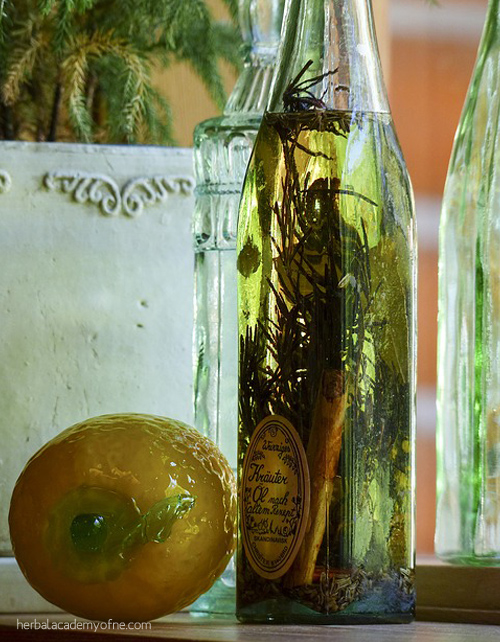 Double Boiler Method
Double Boiler Method
Place the herbs and oil in a double boiler or a make-shift double boiler (see below) and bring to a slow simmer. Slowly heat for 30-60 minutes, then cool and strain. Keep the heat nice and low for a longer simmer time and to help release medicinal properties.
For a make-shift double boiler, find a large pot or pan that will completely hold another, smaller pot. Place water in the larger pot. Pour oil and herbs into the smaller pot, and place inside the larger pot with the water. Be careful not to splash any water into the oil. Keep an eye on the water level and replace water as needed.
Oven Method
Place herbs and oil into oven proof glass or ceramic dish and heat the mixture at a low heat (100-140 degrees F) for 3-5 hours. Cool the mixture then pour through a cheesecloth lined strainer into a bowl with a spout.
Crockpot Method
Place herbs and oils into crockpot and set on lowest heat (usually about 80 – 125 degrees F). If you don’t know your heat settings, use a kitchen thermometer to make sure the oil isn’t too hot. Heat uncovered for 2-4 hours, allow to cool, then carefully strain.
Tasty culinary herbs work best for making infused oils to add to your meals. Garlic, ginger, rosemary, sage, thyme, oregano, parsley, cilantro, turmeric, basil and cayenne are all popular and delicious choices!
Rosemary Infused Olive Oil
Dried rosemary
Enough extra virgin olive oil to cover
- Place the rosemary in your chosen infusion vessel, which will depend on the method you’re using.
- After the infusion process is complete, strain carefully, bottle, seal, label, and store in fridge.
- Enjoy!
THE KITCHEN DOORYARD
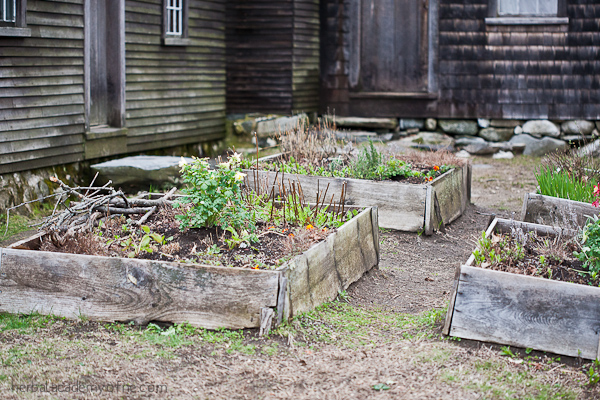
In colonial New England, many folks set up “dooryards” in the semi-enclosed area between the kitchen and the outbuildings to grow food, herbs, hang laundry, chop wood, and other tasks made a little more comfortable in the protected area sheltered from cold and wind. While dooryards are now a feature of the past, we can re-create the concept of a dooryard garden by creating a special, protected space to cultivate herbs in our backyards, pots on our porches, or even on our windowsills to keep fresh herbs within arm’s reach, whether for our daily cooking or medicine making.
Gardening is a profound relationship, allowing us to sink our hands into the earth, sculpt the land, feel the sun on our face, and to escape from ubiquitous digital screens. As we tend to the plants, are we not also tended and healed? The conscientious medicine makers, the “green herbalists,” take the time to acknowledge the plants as parts of communities that depend on a relationship within their ecosystem as well as with the harvester.
Some ideas for getting started:
- When purchasing herbal seeds and seedlings, look for the labels “organic” or “sustainably wild-harvested.” Plant populations can be decimated from overzealous and unconscious wild-harvesters.
- Choose plants you already use in cooking or in tea, culinary herbs like sage, thyme, basil, rosemary, mints, etc.
- Calendula, Calendula officinalis produces orange or yellow flowers that can be harvested soon after opening when they feel a bit sticky. Pop off the flower and more blooms will follow all summer. The can grow in a pot on a sunny windowsill or in the garden. Dried flowers can be infused into oil for skin, made into tincture, or as a tea.
- Thyme, Thymus vulgaris: has anticatarrhal, carminative, antimicrobial and other properties. Grows well in full sun and dry soil.
- Echinacea, Echinacea angustifolia and E. purpurea attract pollinators. Harvest the root in the third year to tincture.
- Chamomile, Matricaria recutita: A popular nervine, carminative, and anti-inflammatory, chamomile is easy to grow and can be direct seeded into soil or a pot in spring. To produce continual flowering, harvest flowers daily. Dry flowers for tea.
- Peppermint Mentha piperita: Grows well in a pot or in a garden, but give it space. Use for GI discomfort and during cold/flu season.
- Basil: high in vitamins and used for depression and sleeping problems. Prefers at least 6 hours of sun a day and moist soil.
- Lemon Balm Melissa officinalis: A mint family plant, also give it room to grow, as it goes rampant. Lemon balm is a lovely addition to teas and supports nervous system and digestion.
Guidelines for Growing
Individual guidelines depend on a case-by-case basis and what plant hardiness zone you live in, but we can offer some general guidelines for a beautiful, healthy garden.
Well-Drained Soil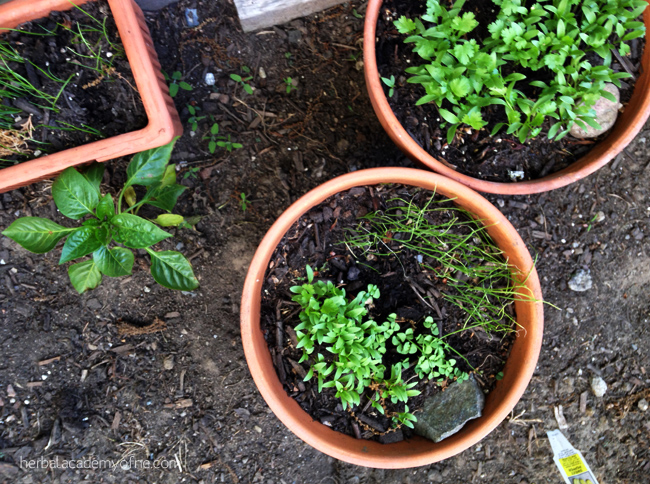
Most herbs prefer well-drained soil, which as the name suggests is a type of soil that allows water to move freely through the ground. Well-drained soil prevents the tendency of water to pool around roots, which can end up harming the plants. If growing in pots, use pots with drainage holes and don’t allow water to pool in the catch tray. If your soil is compacted, you may wish to add small amounts of sand around the roots to enhance drainage.
Soil Amendments
When you grow herbs in your garden or in pots, take care to offer them nourishment through organic methods. Fertilize them with compost (or kelp, compost tea, or alfalfa meal), never use pesticides or herbicides to kill the weeds where you want to establish your garden. It is true that plant medicine is often found to be stronger when they grow in competition with other herbs, what some call “weeds.” We know the truth, of course: the weeds are what we seek for our medicine, for they make the best medicine.
If you are starting a garden from scratch, add humus or compost at least two inches deep before aerating the soil with a digging fork. Raised beds are also recommended to lift the root structures up from any contaminated ground. Never use treated wood for your garden frames, as over time chemicals will leach into the soil.
Location, location, location.
If planting near your home, plant raised beds located away from the roof drip line to minimize exposure to roofing chemicals and contaminants. Look for a sunny spot that receives at least 6 hours of sun a day (this may need to be adjusted if you live in a very cold or very warm climate). If your gardening area is a bit shady, not to fear: there are herbs that enjoy shade. For more information on shade loving herbs, check out our blog article 5 Herbs That Grow in the Shade.
When tending your garden, keep a basket nearby to save those edible “weeds” like dandelion, purslane, and lambsquarters. For more gardening advice, read the numerous gardening articles on our website!
Guidelines for Harvesting
The best time to harvest most plants is on a dry day in the late morning after the early morning dew has dried and before the high noon sun burns away newly produced essential oils.
For some plants like nettles and mints, you can cut the top six inches of the plant; other plants you can just break off individual leaves or flowers, such as calendula and rose. Roots, which are most often dug up in the spring or autumn can be scrubbed.
Preserving Your Herbs
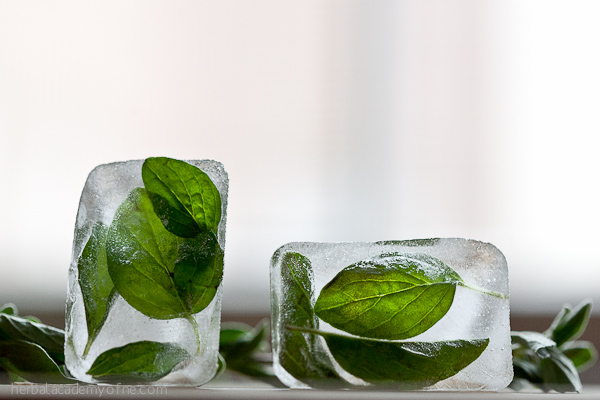 After we bring home the harvest from the garden, we may wish to put up some herbs for the fall and winter months by preserving them through drying or freezing.
After we bring home the harvest from the garden, we may wish to put up some herbs for the fall and winter months by preserving them through drying or freezing.
When drying herbs, spread the plant material over a perforated surface (like a screen or basket) that allows air to circulate around it. This method is best for some seeds, plants with short stems and plants like rosemary that have heavily leaved stems and may promote the growth of mold if bunched together. This method is also good for drying heartier leaves like bay leaves that you may separate from the stem and lay individually to dry. When using the flat drying method, do not pile the plants on top of each other, spread them out giving each its own space, every day or two turn the plants over to make sure that they are drying on all sides.
Some herbs like basil are best used fresh. Instead of drying, they can be blended up with a bit of water, portioned into ice cube trays, and frozen. When frozen through, simply place into a freezer bag for storage.
WILDCRAFTING AND FORAGING
“Wildrcrafting” is a term used to describe the practice of harvesting plants from the wild or uncultivated places. If you’ve ever picked wild blueberries while on a hike, you may have experienced an uncanny sense of “remembering,” a feeling of rightness and fulfillment. Wildcrafting is truly in our blood, because at one time most of the plants humans ate were foraged and gathered. Wildcrafting is not limited to the wilderness, as many plants like plantain and dandelion love to grow around human places.
Wildcrafting provides us with a deep connection to the land, a connection that comes with great responsibility. United Plant Savers is a non-profit founded by Rosemary Gladstar and other concerned herbalists to educate people about medicinal plants that are endangered and at risk in the wild. If you feel the need to use one of the plants on these lists, never gather from the wild. Instead, choose an organically cultivated source, grow them yourself, or use an analogue—there are often other plants or combinations of plants that can replace these endangered specimens.
Plants on UPS “At-Risk” List
- American Ginseng – Panax quinquefolius
- Black Cohosh – Actaea racemosa (Cimicifuga)
- Bloodroot – Sanguinaria canadensis
- Blue Cohosh – Caulophyllum thalictroides
- Echinacea – Echinacea spp.
- Eyebright – Euphrasia spp.
- False Unicorn Root – Chamaelirium luteum
- Goldenseal – Hydrastis canadensis
- Lady’s Slipper Orchid – Cypripedium spp.
- Lomatium – Lomatium dissectum
- Osha – Ligusticum porteri, L. spp.
- Peyote – Lophophora williamsii
- Sandalwood – Santalum spp. (Hawaii only)
- Slippery Elm – Ulmus rubra
- Sundew – Drosera spp.
- Trillium, Beth Root -Trillium spp.
- True Unicorn – Aletris farinosa
- Venus’ Fly Trap – Dionaea muscipula
- Virginia Snakeroot – Aristolochia serpentaria
- Wild Yam – Dioscorea villosa, D. spp
Guidelines for Wildcrafting
Location. When wild harvesting, gather plants that are at least 50 feet back from the edge of the road, never gather near telephone lines (pesticides are usually sprayed there), and not under roof drip lines (roofing materials leach toxic material). Do not harvest near old, lead-painted buildings, industrial sites, or other areas at risk for soil contamination.
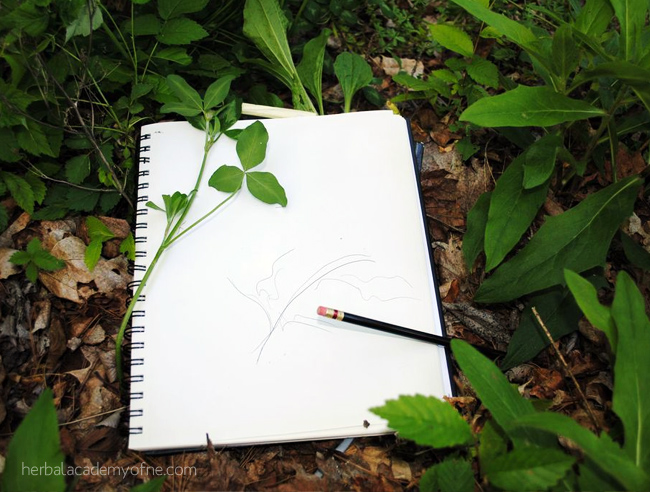 Identification. Accurate identification is essential. Just because it’s “natural” does not mean it’s safe. There are toxic plants that appear very similar to edible herbs and plants so you must be 100% certain of a plant’s identity before using. Some mistakes can be deadly. If there is even a shadow of doubt in your mind, do not use it. Attending plant walks with an expert is the best way to learn gradually with practice and supervision. Always cross-check identity of plant in at least two references (see resources section).
Identification. Accurate identification is essential. Just because it’s “natural” does not mean it’s safe. There are toxic plants that appear very similar to edible herbs and plants so you must be 100% certain of a plant’s identity before using. Some mistakes can be deadly. If there is even a shadow of doubt in your mind, do not use it. Attending plant walks with an expert is the best way to learn gradually with practice and supervision. Always cross-check identity of plant in at least two references (see resources section).
Gratitude. It is with great care and a gentle, thankful spirit that we should approach the plants to ask them if they will offer themselves up for harvest. Think how different the world would be if each person did this only once, and also practiced approaching other living beings—animals, a co-worker, one’s child, spouse, or neighbor—with this same spirit of care. Giving thanks to the plant can help cultivate a spirit of much-needed humility in humans.
Respect. Please remember that you are visiting the plants in their home. A few good manners will go very far in keeping alive abundant and thriving plant populations for the next seven generations beyond us. As a general guideline, harvest no more than 7-10% of the plant community you are visiting in the wild. Monitor the health of the plant community and adjust your harvesting accordingly and provide care to the area if the population is faltering. If there are insects sipping nectar from a flower you’d like to harvest, wait until they fly away before picking .
Proper Use. Be absolutely certain you will use your harvest, and only take what you will use. If for some reason you are unable to use your harvest, compost it so the earth can use it again instead of throwing into plastic trash bags. This is a good general guideline for all uses of plants, including cultivated food. Setting up a compost system is an easy way to significantly decrease your footprint. For guidelines, please see our article How to Compost: Getting Started Guide.
Wildcrafting Resources
The Forager’s Harvest: A Guide to Identifying, Harvesting and Preparing Edible Wild Plants (Eastern U.S., Canada, the Rocky Mountains, and Pacific Northwest) by Samuel Thayer
A Field Guide to Medicinal Plants and Herbs: Of Eastern and Central North America (Peterson Field Guides) by Steven Foster
Edible and Useful Plants of the Southwest: Texas, New Mexico, and Arizona by Delena Tull
Medicinal Plants of the Pacific West, by Michael Moore
Take a Hike Plant Finder Checklist
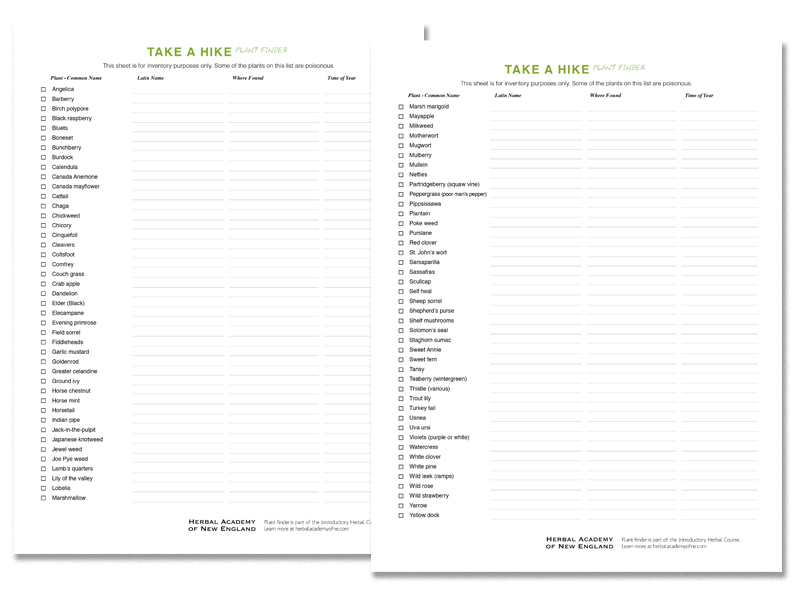
HANE’s Take a Hike Plant Finder Checklist is available for download in the Introductory Herbal Course
A Few Favorite Wild Herbs
![]()
Stinging Nettle – Urtica diocia – Leaf, Root
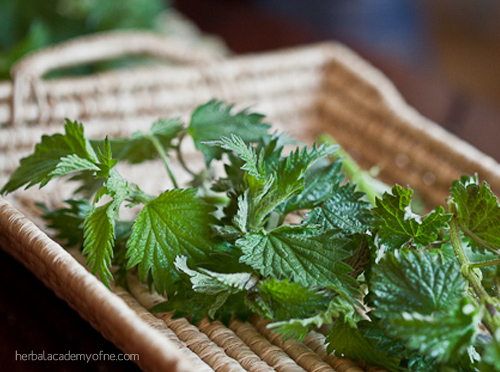 Native to Europe, stinging nettles flourish in the rich soil near barns and cow pastures. While their prickly sting is considered a nuisance by hikers and famers, nettles are the popular, cool kid of the herbal world—herbalists love nettles! As an herb, nettles are alterative, diuretic, tonic, astringent, anti-allergenic, and anti-inflammatory.
Native to Europe, stinging nettles flourish in the rich soil near barns and cow pastures. While their prickly sting is considered a nuisance by hikers and famers, nettles are the popular, cool kid of the herbal world—herbalists love nettles! As an herb, nettles are alterative, diuretic, tonic, astringent, anti-allergenic, and anti-inflammatory.
Freshly tinctured nettles can be useful in cases of hay fever and allergies. Dried nettles are useful for all other indications including skin problems and arthritis. They are highly nutritious, with good quantities of calcium, magnesium, zinc, and other minerals and vitamins. Used in cooking, their leaves are delicious in pesto and soups – treat how you would spinach. They lend a comforting, almost milky mineralness to teas. If stung by nettle, you can squeeze a little of the leaf juice on the sting for relief.
Harvest nettles before flowering in the spring. Wear gloves and use a scissor, cutting off the first few inches of the stem. If the first harvest is early enough, it may be possible to get a few more harvests in before they flower.
Safety: Some allergic reactions have been reported.
![]() Dandelion – Taraxacum officinale – Entire Plant
Dandelion – Taraxacum officinale – Entire Plant
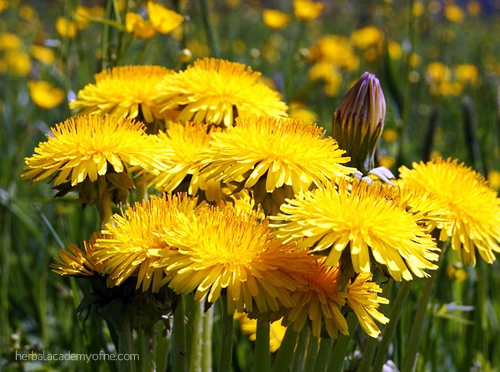 A springtime cleansing tonic found commonly in front and back yards, dandelion root provides all around support to the liver, and its bitter taste promotes digestion. The root can be dug up in the spring for bitter roots and in the fall for sweet roots, and can be roasted and used as a taste replacement for coffee to help someone transition away from coffee. Extract the entire root from the ground and scrub well, then slice it from top to bottom and lay out to dry.
A springtime cleansing tonic found commonly in front and back yards, dandelion root provides all around support to the liver, and its bitter taste promotes digestion. The root can be dug up in the spring for bitter roots and in the fall for sweet roots, and can be roasted and used as a taste replacement for coffee to help someone transition away from coffee. Extract the entire root from the ground and scrub well, then slice it from top to bottom and lay out to dry.
Dandelion greens should be harvested when their crown of leaves is new and still slightly purple. These less bitter greens are used primarily for their diuretic action and high minerals. To increase mineral content in tea, they can be steeped over night. Fresh dandelion greens can be added to salads or sautes and casseroles. Those seeking bitterness can harvest leaves all season long.
The yellow flowers can also be eaten, in salads or battered up as fritters for a treat! Pop off the open yellow flower, leaving the green sepal behind if you would like to avoid their bitter flavor
![]()

Burdock – Arctium lappa, A. minus – Root, Seed
Burdock is a biennial herb that can be grown in the garden or harvested from the wild. The root should be harvested in the fall of the plant’s first year or the spring of the second year before it sends up its flower stalk—these are times when most of the plant’s energy is in its root. Root dug in the fall, however, will have the highest inulin content, which helps feed beneficial gut bacteria. Also slightly bitter, burdock not only feeds the gut flora but tonifies the digestive system itself. Burdock root is also hypoglycemic, mildly lymphatic (improves the flow of lymph through the body), and anti-inflammatory with a special affinity for the skin.
Burdock root can also be eaten as a vegetable—try pickling it or add it to your stir-fry or soup!
![]()
Lambsquarters – Chenopodium album – Leaves
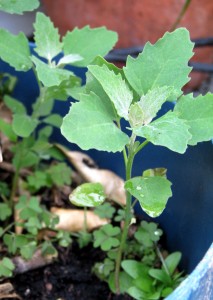
The lambsquarters plant is also called “goosefoot” because its leaf is shaped like a goose’s foot, or “pigweed” because it was often grown to feed pigs. It is often found in lowland gardens as a weed although I have seen it growing in the city next to light poles and around street signs. In A Modern Herbal by Maude Grieve, lambsquarters is said to “rejoice in old manure heaps.”
Its stem is ribbed with alternating leaves that have a pearl-like white sheen. In the old days, lambsquarters were used as a nutritious and wholesome pot-herb, served usually boiled or steamed. It can be used in place of its relative spinach, as the taste is quite similar, in quiches, soups, casseroles, or stir-fries. The leaves are high in calcium, potassium, iron, and vitamins.
They are best harvested while young because as they grow they branch out in a tree-like fashion and produce seedy tips. The seeds can be harvested and consumed as well, although they require much effort to extract!
![]()
Seasonal Wildcrafting
Is there anyone more giddy than an herbalist in springtime? After a long winter, those first green shoots of nettle and dandelion are a glorious sight to behold. But then comes summer with its luscious mints, strawberries, and blueberries; fall is the season to harvest roots along with apples and Hawthorn berries; and winter with its time for reflection and enjoyment of all the plants we have put up for tea and medicine. Each season unfolds its unique gifts, and knowing what to look for when will help you feel more in tune with the rhythm of the year.
Please enjoy the printable chart below that will assist you in learning basic botanical identification. Remember to first learn plant identification with a mentor, and always cross reference your positive ID in at least two reliable sources.
Spring: Look for chickweed, cleavers, coltsfoot, dandelion leaf and root, horsetail, nettle, plantain, usnea, violet
Summer: Blue vervain, blackberry leaf, boneset, elder flowers, ground ivy, goldenrod, plantain, hawthorn flower and leaf, joe pye weed, motherwort, mugwort, mullein flower and leaf, raspberry leaf, rose petals, self-heal, St. John’s wort, wild cherry, yarrow
Fall: Angelica, barberry, blackberry root, burdock root, dandelion root, elecampane, rose hips, valerian root, wild carrot seed, yellow dock.

HANE’s Plant Identification Basics Chart is available for download in the Introductory Herbal Course
REFERENCES
Gladstar, Rosemary. (2001). Rosemary Gladstar’s Family Herbal. North Adams, MA: Storey Publishing.
Green, James, (2000). The Herbal Medicine-Maker’s Handbook. New York, NY: Crossing Press.
This is ONE preview lesson taken from UNIT 3 in the Online Introductory Herbal Course. The Introductory Herbal Course is made up of 6 units including over 30 lessons and bonus lessons. To learn more about the beginners program, please visit this page. If you are interested in registering for the program, skip to registration.

